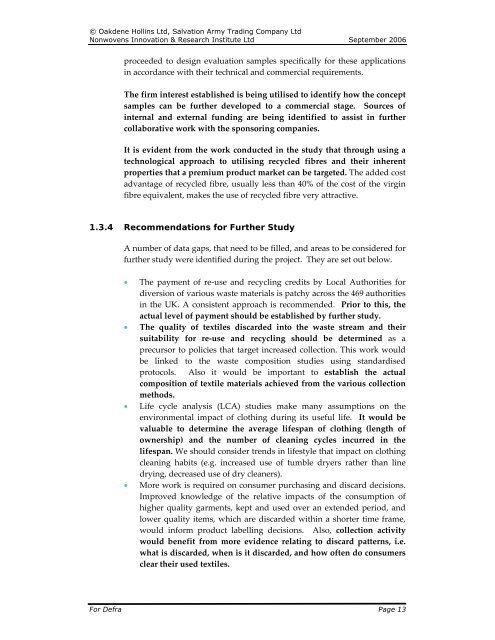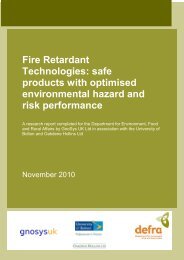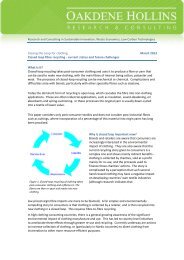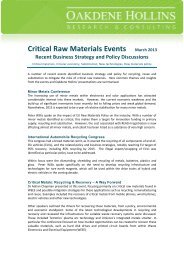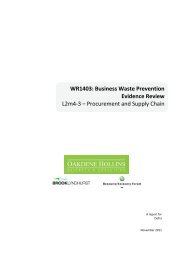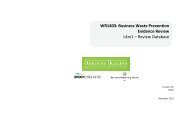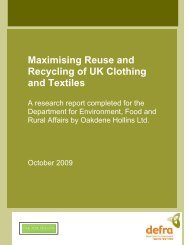Recycling of Low Grade Clothing Waste - Oakdene Hollins
Recycling of Low Grade Clothing Waste - Oakdene Hollins
Recycling of Low Grade Clothing Waste - Oakdene Hollins
Create successful ePaper yourself
Turn your PDF publications into a flip-book with our unique Google optimized e-Paper software.
© <strong>Oakdene</strong> <strong>Hollins</strong> Ltd, Salvation Army Trading Company Ltd<br />
Nonwovens Innovation & Research Institute Ltd September 2006<br />
proceeded to design evaluation samples specifically for these applications<br />
in accordance with their technical and commercial requirements.<br />
The firm interest established is being utilised to identify how the concept<br />
samples can be further developed to a commercial stage. Sources <strong>of</strong><br />
internal and external funding are being identified to assist in further<br />
collaborative work with the sponsoring companies.<br />
It is evident from the work conducted in the study that through using a<br />
technological approach to utilising recycled fibres and their inherent<br />
properties that a premium product market can be targeted. The added cost<br />
advantage <strong>of</strong> recycled fibre, usually less than 40% <strong>of</strong> the cost <strong>of</strong> the virgin<br />
fibre equivalent, makes the use <strong>of</strong> recycled fibre very attractive.<br />
1.3.4 Recommendations for Further Study<br />
A number <strong>of</strong> data gaps, that need to be filled, and areas to be considered for<br />
further study were identified during the project. They are set out below.<br />
• The payment <strong>of</strong> re‐use and recycling credits by Local Authorities for<br />
diversion <strong>of</strong> various waste materials is patchy across the 469 authorities<br />
in the UK. A consistent approach is recommended. Prior to this, the<br />
actual level <strong>of</strong> payment should be established by further study.<br />
• The quality <strong>of</strong> textiles discarded into the waste stream and their<br />
suitability for re‐use and recycling should be determined as a<br />
precursor to policies that target increased collection. This work would<br />
be linked to the waste composition studies using standardised<br />
protocols. Also it would be important to establish the actual<br />
composition <strong>of</strong> textile materials achieved from the various collection<br />
methods.<br />
• Life cycle analysis (LCA) studies make many assumptions on the<br />
environmental impact <strong>of</strong> clothing during its useful life. It would be<br />
valuable to determine the average lifespan <strong>of</strong> clothing (length <strong>of</strong><br />
ownership) and the number <strong>of</strong> cleaning cycles incurred in the<br />
lifespan. We should consider trends in lifestyle that impact on clothing<br />
cleaning habits (e.g. increased use <strong>of</strong> tumble dryers rather than line<br />
drying, decreased use <strong>of</strong> dry cleaners).<br />
• More work is required on consumer purchasing and discard decisions.<br />
Improved knowledge <strong>of</strong> the relative impacts <strong>of</strong> the consumption <strong>of</strong><br />
higher quality garments, kept and used over an extended period, and<br />
lower quality items, which are discarded within a shorter time frame,<br />
would inform product labelling decisions. Also, collection activity<br />
would benefit from more evidence relating to discard patterns, i.e.<br />
what is discarded, when is it discarded, and how <strong>of</strong>ten do consumers<br />
clear their used textiles.<br />
For Defra Page 13


